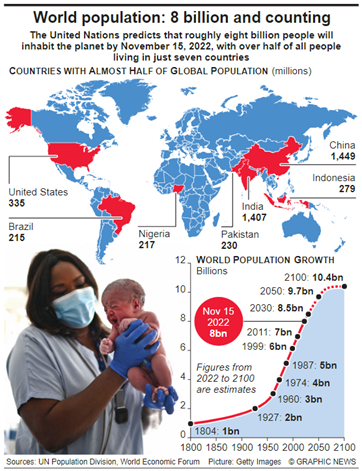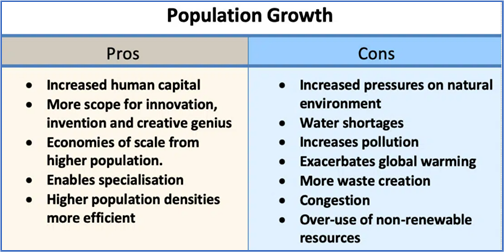





Disclaimer: Copyright infringement not intended.
Context


Advantages of population growth
More people leads to greater human capital
If there are more people, the probability of finding a genius like Einsterin, Marie Curie, Beethoven increase. These exceptional people can lead to technological and cultural masterpieces which enrich our lives. The past 200 years have shown exponential growth in technical development and innovation. There are many factors behind this, but the world’s growing population means we have a bigger pool of human capital and the possibility of these cutting-edge discoveries increase.
Higher economic growth
Population growth will lead to economic growth with more people able to produce more goods. It will lead to higher tax revenues which can be spent on public goods, such as health care and environmental projects.
Economies of scale
Farming and industry have been able to benefit from economies of scale, which means as the population grows, food output and manufacturing output have been able to grow even faster than population growth. For example, at the turn of the nineteenth century, Thomas Malthus predicted population growth would lead to famine as we would be unable to feed the growing population. However, his dire predictions failed to materialise because he failed to understand, that the productivity of land, labour and capital could all increase more than proportionately. 300 years ago, most of the population worked on the land. Technological innovation and economies of scale, mean productivity of land has vastly increased as farmers make use of mechanisation and economies of scale for increased food production.
The efficiency of higher population density
In terms of per capita carbon footprint, areas with a high population density are significantly more efficient than rural areas and places with a low population. When people live in densely populated areas, they are more likely to use public transport, live in apartment buildings which are easier to heat. In big cities, transport and the delivery of goods is much more efficient, whereas for low population densities, the average cost and environmental footprint are much higher. Therefore, population growth which leads to growth in city connurbations (which is a feature of global growth in past) is not as environmentally damaging as we may think. In Green Metropolis, by David Owen he argues living in closer proximity in cities is a key aspect of sustainability.
The improved demographic structure of society
Many western economies are now experiencing a falling population, with the result that their population demographic is being skewed to old, retired people. This is imposing costs on society as we struggle to pay for health care and pensions. Moderate population growth helps to rebalance the population with a higher share of young, working people.
Critical mass
Higher populations can enable a critical mass of people to enable a sider, more vibrant society. With low populations, there is less scope for diversity. But, when the population grows, it can enable the support of a broader cultural range of activities.
Disadvantages of population growth
Cost to the environment
Population growth exacerbates many of the existing environmental problems
Trying to reduce carbon and methane emissions to reduce global warming is relatively more difficult as the population.
There will be greater threat on natural habitats as a greater population has greater demand for housing and farmland. This will increase pressure to cut down forests to make way for farming and housing.
Higher population will lead to a greater consumption of non-renewable resources, leading to a faster depletion of natural resources.
Higher population will lead to greater pollution levels in air, water and land. Higher pollution is associated with a range of health issues, such as cancer and asthma. The pollution also harms animals and plants.
Soil degradation. To feed a growing planet, we have seen serious degrading of farmland. This is due to factors, such as overgrazing, use of chemicals, climate change and use of chemicals.
Congestion
Too many people in a small space will lead to various types of congestion. Road congestion is a major problem across the world. With population growth, the costs of congestion will only increase leading to time lost, more pollution and lost output.
Water shortages
Already up to 40% of the world’s population face water scarcity and the risk of drought. A growing population will put pressure on scarce water supplies and this is a factor behind many minor and major conflicts with countries having to find ways around the shortage of water.
Generating unsustainable waste
We are currently generating non-biodegradable rubbish that we are struggling to process. It tends to end in landfill, causing methane emissions and other toxic problems.
Problem of Unemployment
Large size of population results in large army of labour force. But due to shortage of capital resources it becomes difficult to provide gainful employment to the entire working population. Disguised unemployment in rural areas and open unemployment in urban areas are the normal features of an under developed country like India.
More Pressure on Land
Rising rate of population growth exerts pressure on land. On the one hand, per capita availability of land goes on diminishing and on the other, the problem of sub-division and fragmentation of holdings goes on increasing. It adversely affects the economic development of the country.
Pressure on Environment
Population explosion leads to environmental degradation. Higher birth rate brings more pollution, more toxic wastes and damage to biosphere. Briefly speaking, population explosion hinders the economic development.
Rapid Population declines Social Infrastructure:
A welfare state line India is pledged to meet social needs of the people adequately and for this, the government has to spend a lot on providing basic facilities like education, housing and medical aid. But rapid increase in population make burden all the more heavy.
Decrease of forest area:
The basic made of the growing population is of residence and shelter. To construct houses and place of shelter, man is greatly cutting and reducing forest to make a place to live.
Environmental pollution
Over populated passion creates a large affect on the environment by exhausting a large proportion of waste. On the other hand reducing forest which results the growth of pollution.
Education
The low income of large family dose not afford to provide education to their children. Which results into creating a problem of illiteracy and again none awareness among the class.
Energy crisis
Population explosion accompanied with rapid industrialization and urbanization has led to greater demand for already deficient energy (fuel wood, fossil fuel and electricity).
Pressure on food, clothing & housing
A country with fast growing population has to face a serious problem of scarcity of necessary food, minimum clothing & proper housing facilities, which are basic needs of human life. Thus, it affects the life style and results slum areas, starvation etc.
Standard of living
The overpopulation creates or give rise to large families with low income reducing the standard of persons living therein. The slum areas, starvation and frequently epidemics are the results affecting health and standard of persons within such nation.
Eco-degradation
Overpopulation leads to eco-degradation by increasing air, water, soil and noise pollution, unhygienic condition, deforestation leading to flood and soil erosion. So rapid human population growth is creating increased pressure on the infrastructure, economy, environment, availability of primary health care and nutrition.
India in the context of Population Explosion
India has just two per cent of the world’s landmass and 16 per cent of the global population. Between the Census of 2001 and 2011, the country added 18 per cent more people to its population — translating to around 181 million. It is the second-most populous country in the world. According to the Population Division of the UN Department of Economic and Social Affairs, India is expected to surpass China’s population soon. In this context, the importance of sexual and reproductive health of women and planned parenthood underscores some major concerns for the country.
How India is placed:
Looking Forward
Population growth constantly acts as a hurdle in effectively addressing the problem of poverty, hunger and malnutrition and in providing a better quality of health and education, with limited resources. It is, therefore, important to understand that in order to have a better future for all on a healthy planet, attainment of the SDGs is critical.
Family planning is an effective tool to ensure a stable rise in the population, which in turn is crucial for the achievement of some of these SDGs. The Government at all levels — Union, State and local, citizens, civil societies as well as businesses — must take the responsibility to promote awareness and advocate the sexual and reproductive rights of women and encourage the use of contraception. This would go a long way in ensuring that every child who is born would prove to be an asset for the country, as all the research shows that investing in family planning and well-being measures have significant benefits over per Rupee spent vis-à-vis other investments.
Additionally, the key stakeholders need to be committed to well-researched planning and implementation on how to harness the population growth for the maximum economic benefit of the society and country. Providing adequate education and training to the young population would make them productive, effective and competent, thereby making them key contributors to economic growth.
The government must not enact policies in contravention of the principles laid down in the National Population Policy that require a focus on the well-being of people by providing opportunities and choices to all in every sphere – health (including maternal, neonatal and child), safe and quality contraception, education, food, housing, political and economic opportunities and others that can effectively and automatically bring about a decline in the fertility rate.
India needs some serious measures to control the population. Though there is reduction in the no. of children than before, the growth curve has yet to flatten. Incentives, disincentives, education and awareness are the best ways to control the population.
https://www.thehindu.com/news/international/humanity-hits-the-eight-billion-mark/article66139348.ece






© 2025 iasgyan. All right reserved